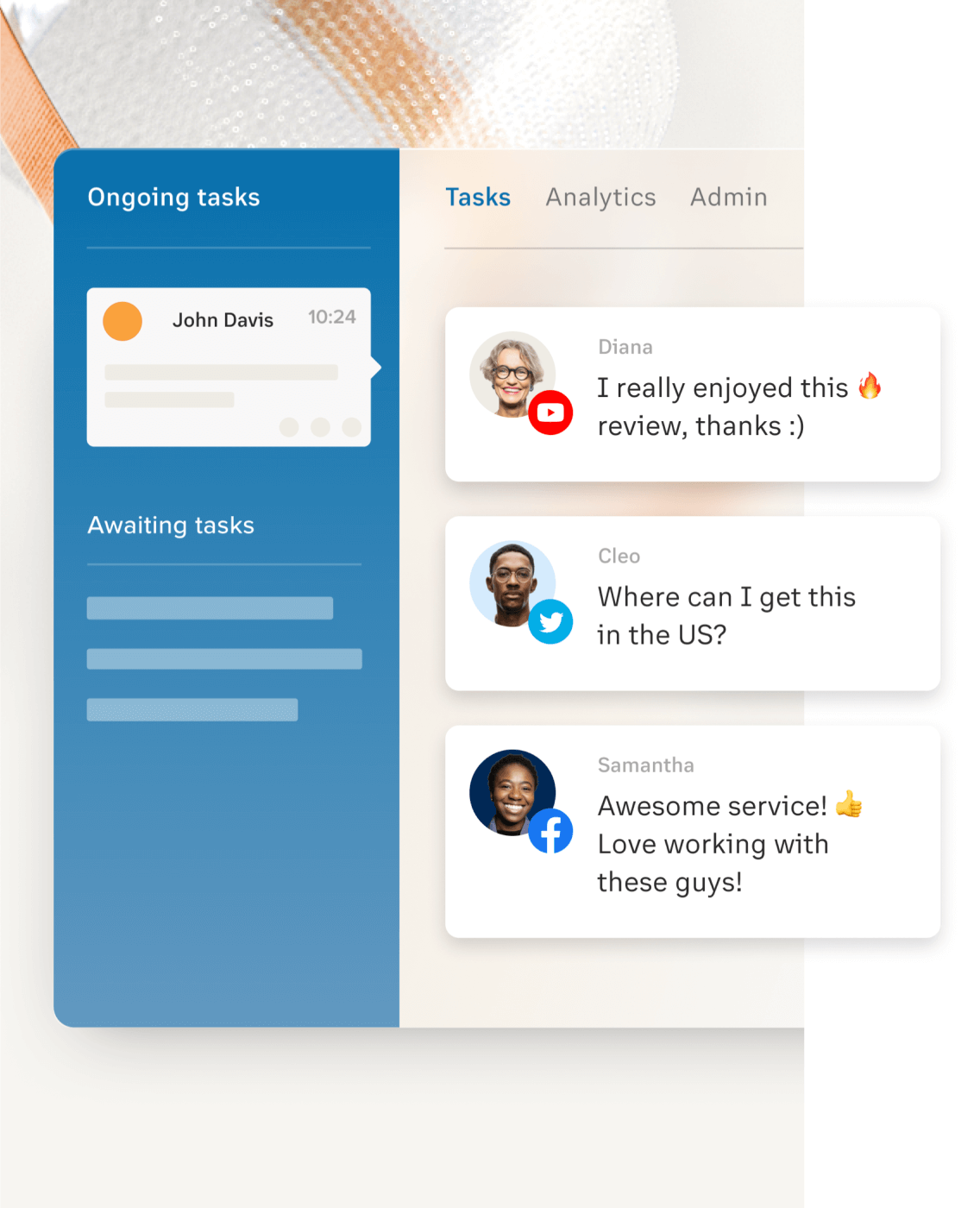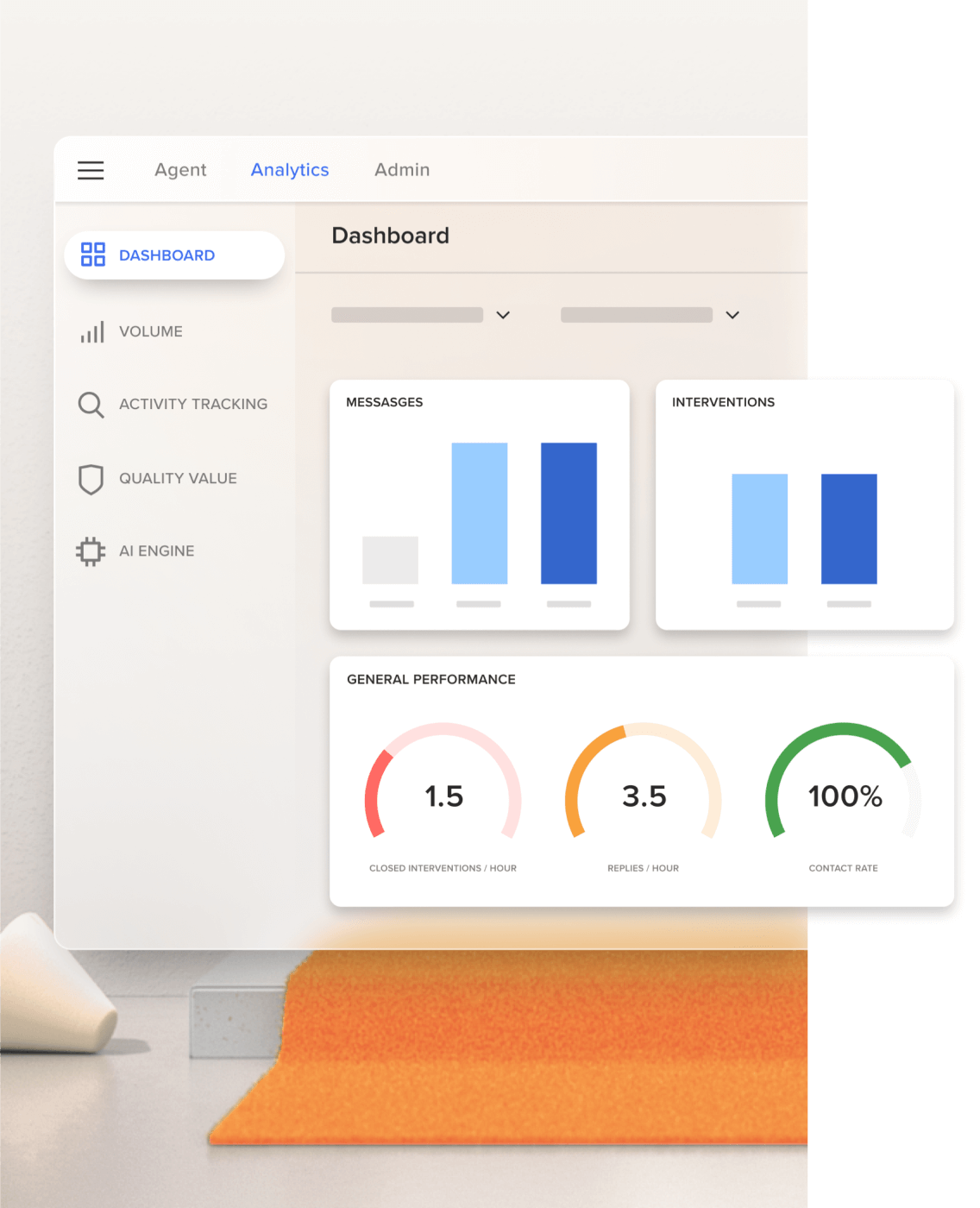Excellent customer service is key to any business, large or small. Many companies turn to contact centers or call centers to assist them with their customer’s needs. However, as more small businesses expand their social media presence, the greater need there is to deliver customer service on those platforms.
So, let’s get into it. Today, we’ll cover:
- What is social media customer service?
- Why small businesses should use social media for customer service
- The main pitfall of social media customer service
- How to deliver great customer service on social media
⭐️⭐️⭐️⭐️⭐️ Ready to offer 5-star customer service? Get strategies for every stage of the customer journey with this free eBook.
What is social media customer service?
Social media customer service is an important piece of an overall digital customer service strategy. In a nutshell, it’s your ability to provide customer support via social apps like Facebook, LinkedIn, and Instagram.
Social media sites have evolved in recent years to become more than just a place to advertise products. These platforms have become key in providing customer service. 18.7% of U.S social buyers completed their most recent purchase without leaving the social app. Providing a place for customer requests and questions within that same experience is going to be key in setting your small business apart from others.
The primary goal of social media customer service is to offer customers a simple and enjoyable support experience on the channel they prefer. Your business’s social media support can be handled by a dedicated team or by your call center. To provide effective social media support, businesses must implement specialized social media management training, workflows, and software solutions for streamlining and resolving customer issues.
Why small businesses should use social media for customer service
Social media customer service is preferred by many customers because it’s accessible, convenient, and always on. They can get customer support wherever they are, on any device. For this reason, a presence on these apps is essential to give your brand the competitive edge it needs in today’s saturated market.
Being able to contact brands and businesses is seen as a given to millennials and Gen Z, too, so if you want to attract a younger audience, it’s definitely time to dust off those business social accounts and make them work for you.
The main pitfall of social media customer service
To do social customer service right, you need to remain aware of the complexities involved. One huge issue to consider before diving in head-first? Response time.
Social media is an exercise in instant gratification, and this doesn’t stop at personal interactions. Customers who reach out to you via social media expect an immediate—or really fast—reply to their problem or question. On Facebook, for example, you might have noticed business pages are even “rated” on their response time to messages.
Weaving social media into your customer service strategy is likely a good choice for any small business, but it could add considerable volume to your service team’s plates. Plus, there are so many apps out there, and they each have their own contact interfaces. So how can you stay on top of all these new channels?
One solution: cloud-based digital customer service software, like RingCentral Engage Digital, that consolidates all of your social profiles in a unified platform:

This way, your team can focus on providing consistent customer service across channels. Plus, anyone on your team can pick up where another rep left off using any desktop or mobile device for shorter wait times on resolution.
How to deliver great customer service on social media
Whether you’re a small business or a large enterprise, there are some simple strategies you can follow to ensure an exceptional customer service experience on social media.
1. Consider creating a dedicated support channel on social media
It’s a good idea to set up specific handles on social media that your customers can reach out to. This helps separate customer care and support requests from your primary social media channels.
For instance, you might have @RingCentral as your regular social media platform and set up a separate account like @RingCentral_help that can be looked after by the customer support team. This ensures that your social media customer service representatives can organize and handle requests more efficiently.
If you’re going to do this, be sure to include a link on your main profile. This’ll ensure customers know how and where to reach your customer service team if they need help. If you get a service request in your main account, hand it over to the right team and reply from your dedicated support account.
2. Create social support guidelines and best practices
Providing social customer support offers different challenges and opportunities to regular social media marketing. To ensure successful social media support, you’ll need to have specific guidelines and best practices in place to ensure your customer service reps are equipped to handle support requests that come through social media.
The guidelines your team follows should align with your business values and the practices of your wider social marketing team. They should cover things like:
- The tone of voice: Your tone of voice should be consistent across channels. It’s a way to show customers your brand’s personality while implementing a tone that ensures you’re approachable and friendly when handling support requests.
- Response time: Again, try to keep your response times consistent across all channels.
- Self-service help center and FAQs: Be sure to provide answers to frequently asked questions as well as a self-service center so customers can find answers to simple questions by themselves. This also ensures they still have a source of information for out-of-hours requests.
- Protocols for handling escalated customer issues: Sometimes customers aren’t always patient or satisfied with the support they receive (even if you are doing your best!) so make sure you have protocols in place to ensure your support staff knows how to handle escalated customer complaints and service issues on social media.

3. Use the right channels
To provide effective social media customer care, you need to be present on the channels where your audience is already spending their time.
Monitor your social network to find out where people are talking about your brand online. You can also look at which platforms your competitors are using, to get an idea of where your target audience is likely to reach out. That’ll help you to prioritize which channels you provide support on.
According to a report by Consumer Reports, 84% of consumers who posted complaints on social media used Facebook and 26% turned to Twitter. Research by Statista shows that Facebook, YouTube, Whatsapp, and Instagram are the most popular social media platforms in 2021, but not all offer the same support functionalities or convenience.
Facebook is essential for providing customers with quick and easy customer support. Facebook Messenger is much like live chat. It’s user-friendly and convenient, so customers can reach out to your business in a one-on-one conversation where they can share confidential information like their email address or numbers related to their purchase order.
Facebook appeals to audiences aged between 18 and 64 years old, so if your audience falls within that demographic, you can benefit from offering support on this channel.
Another essential social platform to offer support on is Twitter. Your Twitter account features a “support option” that lets your customers know you answer support-related queries. You can also let your audience know what your support hours are, so they know when to reach out.
Instagram is another valuable customer service tool that can be used to discover what your followers and the general public are saying about your brand. You can use Instagram to post content and track keywords, hashtags, and mentions of your brand to flag support requests and respond accordingly. You can also take conversations to private messages on Instagram if it’s necessary.
Other platforms to consider offering customer support through include LinkedIn, YouTube, Reddit, Whatsapp, and Snapchat. Whichever platforms you choose, be sure to prioritize the customer experience by creating efficient strategies tailored to each platform and how your audience interacts with them.
With the right channels and by using social listening, you can provide your audience with solutions efficiently and effectively, providing followers with more reasons to become loyal advocates of your brand.
4. Always respond, and respond promptly
It might seem obvious that you should always respond to customers on social media, but you’d be surprised how many companies simply… don’t. Research shows that in the United States, 25% of consumers don’t expect they’ll get a response on social media at all. Even if people who are mentioning your brand on social media aren’t paying customers, it’s still important to respond to show that you provide responsive customer service.
According to a survey by Statista, 68% of consumers expect a response to social media questions and complaints within 24 hours. Moreover, 52% of respondents globally expect a response within an hour! Customers look for support on social media because it’s where they expect to get the fastest response
Being unresponsive on social media is just a bad look for your business. Your Facebook page will even tell visitors how responsive you are!
Even if your customer service isn’t available 24/7, you need to manage customer expectations by making your customer support hours clear and letting them know how they can get support in the meantime (either through your call center or self-service options). On Facebook Messenger, you can set up an automated response when your customer service isn’t available.
It’s also a good idea to consider using templates for providing quick answers to easy questions. For instance, on Instagram, you can use the Quick Replies feature to pre-write responses to common customer questions so you can respond in seconds.
5. Personalize your social media customer service
Personalization is extremely important when it comes to social media customer support. Often, customers can feel like just a number when they receive automated messages or generalized replies.
If you want to improve brand loyalty and customer retention, personalized support is a must. This way, you won’t risk treating loyal customers like strangers because you didn’t realize you’ve already interacted with them in the past.
Here are some tips to help you offer a more personalized social media customer service strategy:
- Ensure your customer support reps use their own names and the customers’, This shows you’re invested in the conversation and encourages them to trust you.
- Know your customers’ history by integrating your CRM with your small business phone system so agents have all the information they need right at their fingertips.
- Give customers the choice of choosing their preferred way to contact you, whether it’s via social media, live chat, email, or a phone number.
To offer truly personalized support, you’ll need to keep track of all your customer information in one place by ensuring your communications systems are integrated. With a tool like RingCentral Engage Digital, you can manage social media interactions across channels:

Moreover, you can automate your customer service interaction workflows with CRM and chatbot integrations as well as live statistics. With all customer information stored and managed in one place, every interaction is seamless.
6. Take public conversations private ASAP
Sometimes frustrated customers leave negative comments on your social profiles, rather than reaching out to customer service. This kind of comment can reflect negatively on your company, particularly if they’re visible to a wide audience or reposted by your followers.
Luckily, through careful social media monitoring and social listening, you’ll be able to pick up on and address customer comments effectively.
Of course, these comments can’t be ignored. Instead of replying publicly, it’s a good idea to take the conversations private.
For instance, if someone posts a comment publicly on your Facebook page, you can respond in a private message on Facebook Messenger. You can handle their comments with any necessary apology while maintaining a friendly tone of voice and offering solutions where possible. You should also address their comments by replying to let them—and anyone else watching—know a member of the customer service team has sent them a direct message.
By speaking with customers one-on-one you can cultivate a more personal customer experience that’s tailored to customer needs. Be sure to address even positive comments privately, as it’ll show customers you value their opinions enough to take the time to reach out to them.
7. Use a virtual agent or chatbot for 24/7 availability
Chatbots are handy features that allow your business to offer basic customer service throughout the day. With chatbots, you can offer always-on support. The ability to provide support 24/7 was the top benefit of chatbots in a survey carried out by Capgemini.
Chatbots can provide customers with immediate, real-time replies to common customer inquiries. This is a great way to continue providing support when your team members aren’t online.
8. Turn customers into brand advocates
If a customer has a negative experience with a business, they’re much more likely to go online and write a bad review.
One of the main goals for your business should be to provide top-notch customer service across all channels. Doing this will help you to create a loyal customer base that’ll advocate for your brand no matter what other people have to say about it.
According to Microsoft, 55% of people aged 18–34 have praised a brand or its customer service over social media—so it’s a great place to start building customer loyalty.
By offering high-quality customer service and being responsive to notifications on social media, you’ll show your audience that you care about what they have to say and are actively seeking to solve any problems they might encounter promptly.
When your customer base become advocates of your brand, they’re more likely to share their opinions with people who can become potential customers.
9. Manage your social interactions from a single platform
It’s more than likely you’ll want to provide social customer support across a variety of customer service channels. Implementing a communications platform like RingCentral Engage Digital that facilitates omnichannel support can help to streamline your social customer service processes.
RingCentral allows you to interact with your customers on their channel of choice by unifying all your digital conversations. Manage interactions across social media accounts, messaging, live chat, email, and reviews from a single platform.
Your customer service team won’t have to spend time switching between apps to manage support requests on different channels. Everything’s under one roof. Get an overview of support requests from Facebook, LinkedIn, Twitter, YouTube, and more from a single user dashboard that records all your customer interactions and data directly in your CRM.
With more customer service reps working from home, a platform like RingCentral Engage Digital empowers your team to access their social profiles and customer information from any device, whether it’s a laptop in the office or a mobile phone on the go.
10. Use metrics and KPIs to measure your performance
If you don’t report and measure your social media customer service activities, you won’t understand how your team is performing and how customers are responding.
Be sure to identify key performance indicators (KPIs) to gauge the success of your support and identify any issues that are coming up. These metrics will be similar to things you measure in a call center, like first contact resolution, response rate, customer retention, and so on.
You can also send a follow-up message to customers from your social profiles asking them to fill out a quick customer satisfaction survey. Armed with this data, you can direct your efforts to fix issues that arise. You’ll also be able to tell whether you need to assign more staff at particular times of the day.
This is another important piece of the puzzle that RingCentral can help with. Engage Digital offers a whole suite of back-end analytics to help your team measure success:

Grow your small business with social media customer service
Nowadays, social media customer service is essential. Consumers have come to expect brands to offer an omnichannel support experience, including social media alongside other support channels like email and call center services.
Having good customer service is imperative if you want to grow your small business. Learn more about what RingCentral can do for your small business.
Originally published Nov 22, 2021, updated Nov 04, 2024




